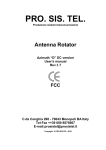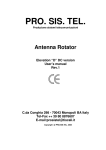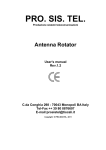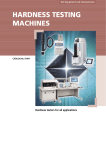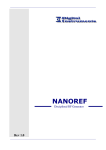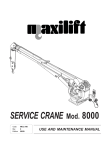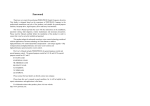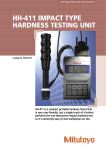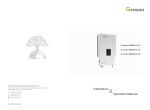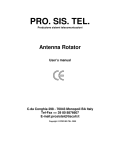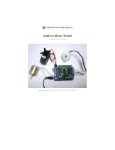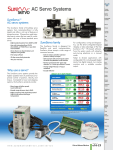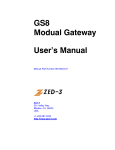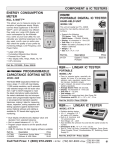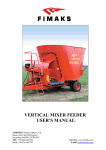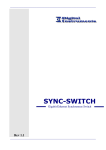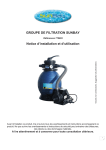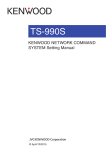Download Get the manual in pdf format
Transcript
PRO. SIS. TEL. Produzione sistemi telecomunicazioni Antenna Rotator Azimuth “D” DC version User’s manual Rev.1.3 FCC C.da Conghia 298 - 70043 Monopoli BA Italy Tel-Fax ++ 39 80 8876607 E-mail:[email protected] Copyright ® PRO.SIS.TEL. 2005 Warning This manual must be read carefully before proceeding to assembly. Warranty 1) The rotator with the control box, hereinafter called “product”, or “rotator”, is warranted for 2 years from date of purchase, provided that it is supported by the document of sale issued by the manufacturer or authorized distributor. 2) The warranty covers replacement or repair of any defective component. 3) This warranty does not apply to product which have been subjected to misuse, negligence, accident, incorrect wiring performed by the user, improper installation or non-compliance to instructions furnished by us, damage to product which has been repaired or altered without authorization or to injury or loss resulting from careless maintenance. The warranty does not cover damage due to transportation and all causes not arising from defects in workmanship. 4) The warranty does not cover costs of transport or insurance for material returned to our workshops. 5) The manufacturer is not responsible for personal injury or property damage resulting from improper or careless use of the product. 6) All product is tested after assembly and is supplied without defect. We exclude the substitution or the prolongation of warranty for a possible damage. 7) After the 2 years warranty period, maintenance or repair will be subject to parts and labor charges. 8) No person is authorized to assume for us any liability in connection with the sale of our products. 9) This warranty does not cover damage to people or things due to misuse, improper or careless installation, or misunderstanding of instructions furnished by us. 10) The right of recession must be exercised in according to the law. 11) Our products are subject to continuous improvement. We reserve the right to implement improvements and changes without prior notification. 12) The legal code applying in MONOPOLI, Italy, will apply, in cases of dispute. 13) Purchasers of product are deemed to accept paragraphs 1, 2, 3, 4, 5, 6, 7, 8, 9, 10, 11, 12 and 13 as above. Model: PST S/N: Date of purchase: 2 Important Read this instruction manual carefully before attempting to operate the antenna rotator. Save this instruction manual. This instruction manual contains important safety and operating instruction for antenna rotator. Precautions ! WARNING, never connect or disconnect rotor cable or RS232 connectors while power is on. This may results in electrical shock or burn. Table of contents Section 1: Description; Section 2: Installation and use; Section 3: Principle of operation ; Section 4: Technical specifications; Section 5: RS232 remote control philosophy; Appendix 1: Declaration of conformity Table: Note: Last up-date 01 July 2005 3 Section 1 The controller “D” version 1-1 Front panels description. 1 - POWER SWITCH (POWER) Turns power ON and OFF 2 – Right lever: CW momentary switch Pushing and holding this switch will make the rotator turn clockwise If you have used the preset, or computer control to start rotation, you can over-ride those commands by momentarily depressing the switch. 3 – Left Lever: CCW momentary switch Pushing and holding this switch will make the rotator turn anti-clockwise If you have used the preset, or computer control to start rotation, you can over-ride those commands by momentarily depressing the switch. 4 - Display The display will show the current bearing in degrees. When the preset knob is turned, the display will show the preset bearing. The decimal points on the LED display blink * when you turn the target position knob on the front panel * rotation begins and is in progress * when rotation is complete. At that time the display will blink for the programmed delay time before further rotations are permitted. (Note - if the CW or CCW keys have been used, further rotations in the same direction are not subject to this delay time) 5 - Preset rotating encoder To preset rotation, turn the knob to the desired bearing. 3 seconds later, rotation towards the preset postion will start, with the display showing the bearing as it changes. "Err" is displayed if the preset knob is turned to a position outside the rotation limits. 4 1-2 Rear panels description. 1 - DB9, RS232 female connector Enables connection to a PC RS-232 port for remote operation. Pin 5 = computer ground Pin 2 = serial data out (to computer data in) Pin 3 = serial data in (from computer data out) 2 - Rotator control cable male connector. Connects the rotator to the controller 3 – AC Power male socket (230Vac or 115 Vac) Connects the rotator to the controller 4 – Fuse holder. 19x5mm, 1.6A fuse is required. 1-3 “D” Controller features. Warning: this is a complex controller, be sure you understand before using it. This controller has several features settable via RS232 and some of such features are even settable manually. A four ways dip-switch allows manual selections. Controller parameters settable in either modes: • Soft start – Soft stop • South stop or North stop • Rotation range 360 or 500 • Calibration • Off-set Controller parameters settable via RS232 only: • Revers delay • Preset delay • PWM duty cycles • Rotation range • Optimizer • Rotor chk Controller display mode settable manually only: • Absolute or relative display mode. • Entering in Absolute mode The controller uses an ADC which accepts 0-5V voltages. The antenna position voltage readout is mapped to be inside the 0-5V range. In the absolute mode the display shows directly the rotator position expressed in absolute degrees: you read values from 0 to 500. In the other operational modes (north/south-stop) the absolute readings are converted into different angular position numbers, but only for input/display purposes: internally the program works with absolute angles. The absolute mode can be only entered turning-on the CBOX with the CW key pressed until the display shows a blinking “---“ (three minus): now you can release the key and the absolute mode is entered. You can move the motor using CW and CCW keys between the rotation limits. To exit from such a mode you must recycle CBOX power (forcing another mode by RS232 command isn’t effective). In the absolute mode the rotor can be only operated by the CW/CCW The absolute mode is usefull for CBOX calibration (see CALIBRATION paragraph). It is NOT recommended to turn big antennas which need to be started and stopped softly. 5 The bearing values in degree as shown by the display, are not absolute but relative, as show in the conversion tables: Vdc Deg. 000 110 east side outrange 070 180 S South stop absolute values 160 250 340 270 000 090 W N E South stop Vdc Deg. 000 290 west side outrange 070 000 S 500 240 west side outrange 430 000 S 500 070 east side outrange relative values North stop absolute values 160 250 340 090 180 270 W N E North stop 430 180 S relative values That mean when the Vdc coming from rotor potentiometer is 0V, the display will show 110 deg. when in South stop (default) and will show 290 deg. when in North stop. With an applied voltage of 2.50V the display will show 000 deg when in South stop and and 180 deg when in North stop, while with an applied voltage of 5V the display will show 240 deg. when in South stop and 070 deg. when in North stop. • The on-board dip-switch There is an on-board dip-switch that allows the user to change some operating modes without using the supplied PC program. Remember that the dip-switch status is read only at power-up and copied into the EEPROM: you must turn-off and turn-on the mains power for a dip-switch change to be effective. There are four switches: • #1: select the source of the three following parameters: if ON the source is the other three switches status, otherwise the relative EEPROM contents modifiable through the W command • #2: operating mode: if ON is north-stop, otherwise is south-stop • #3: rotation range: if ON the rotation range is 0 to 500 absolute degrees, otherwise is 70 to 430 absolute degrees • #4: PWM: if ON the PWM is enabled, otherwise is disabled The above parameters (ENA_PWM, LOWLIM, UPLIM, MODE) are not modifiable by RS232 commands is the switch #1 is ON (dip-switch selected). LOWLIM and UPLIM change accordingly with the POS_OFFSET values. • Soft start and soft stop: A MOSFET controlled PWM is included. When it is in active it permits soft-start and soft-stop for the rotator. Default valoue: included. • South stop or North stop: Via RS232 or on board dip-switch, it’s possible to switch the display reading mode. Default valoue: South stop. • Rotation range 360 or 500: 500 degrees of travel is enabled as the default value. This allows 70 degrees travel past 360 degrees, in both directions. Some users may wish to limit travel to 360 degrees. There are two ways to do this - By setting the on-board dip-switch as described above. - By using the supplied software - which will allow any limits to be set, to one degree accuracy. Note Absolute values must be entered in the input fields. Default valoue: 0-500 Degrees • Calibration Two on board trimmers are provided to calibrate the controller. If necessary, you can recalibrate your controller via RS232. See calibration procedure issue. 6 • Off-set If the initial antenna direction it’s not coincident with the geografic direction, you can fix it manually using an on board off-set trimmer as well via RS232. Default valoue: 0 • Revers delay A reverse delay time is provided. This is to reduce stress on your rotator / tower and antenna systems caused by too-rapid reversal of direction. The default time is 3 seconds, but this may be altered in the software to suit your antenna system. • Preset delay A preset delay time is provided. This allows you time to finalise the preset position before the rotator starts to turn. The default is 3 seconds, which may be altered in the sofware. • PWM duty cycles This feature controls the accelleration / deceleration of the rotator between rest and full rotation speed. This feature is kind to your antenna system as it gives smooth starting and stopping of your antenna. • Rotation range This controller allow you to have 500 degrees of total rotor rotation range with 70 degrees of extra travel for each side. An on board dip switch allow you to choose between two rotations ranges, 0-500 degrees (default) or 0-360 degrees. • Optimiser If you select rotation by preset knob or computer control, the optimiser will determine the shortest direction to target. • Rotor chk If implemented, if you select a target with preset or computer control, the CPU will check the feeback signal from the rotator, and within 5 seconds will prevent the rotator from turning in the event of an abnormality. • Controller internal view • Calibration procedure. Initial calibration is carried out in the factory To use the on-board OFFSET trimmer to perform subsequent calibration 1. Turn the antenna to a known position if the true position differs from the controller display. 2. Adjust the on-board OFFSET trimmer until they are the same. Note The Calibration potentiometer will only permit a minor amount of adjustment. If your antenna position is grossly incorrect, you will need to correct it by repositioning the antenna on the mast. 7 1.4 The rotator The rotator has a unique design. The motor is located on the side of the machine. The motor output shaft terminates on a flange, where different kinds of mast clamp, available from us, may be fixed with bolts. Users may also supply their own clamp. On the motor side is located a five-contact connector for motor power supply and potentiometer terminals. The potentiometer, used as the antenna position reader, is located inside the foot plate, and driven by the transmission output shaft. PST61 – 61HP – 71 PST641 - 2051 Rotor connections PST61 – 61HP – 71 2 PST641 - 2051 1 NC 3 5 4 8 Section 2 Installation and connections 2.1 Unpacking After unpacking, immediately report any damage to the delivering carrier or dealer. Keep the shipping cartoon. 2.2 Power supply connection Connect the power cable and switch power on, display will show PHH. Switch power OFF. 2.3 Rotator control cable preparation & connection Before installing the rotator inside a tower, you need to prepare male connector for remote control cable, make all connections and test rotator operation throughly on the ground, as described below. Connect the rotator and control box with a 5-core control cable. Two cores are used for the motor DC power supply, and three for the position reading potentiometer. If the diameter of the control cable is too thin, it will limit the voltage and reduce the torque. Do not use cable with less than 0.5 mm² of section area. Before connecting rotator and controller, make sure that power switch is OFF. Cable plug Wire no. 1 Wire no. 2 Wire no. 3 Wire no. 4 Wire no. 5 Motor terminals board must be connected to must be connected to must be connected to must be connected to must be connected to 1 (VDC motor power) >= 1mm² 2 (VDC motor power) >= 1mm² 3 (P to pot central lead) 4 (+5 Vdc pot lead) 5 (0 Vdc pot lead/GROUND) Warning: Improper wiring can result in damage to the rotator circuitry when the power is swiched on. Warning: The rotor connector is not fully waterproof, use good quality tape to protect it from rain/umidity THIS IS NOT COVERED BY THE WARRANTY. 2.4 Rotator cable inspection Ensure the cable is correctly wired before connecting it to the controller. To check the rotor cable you need a digital multimeter. Rotator truth table (valid for both ends of the cable) Pins 1 and 2 (internal DC motor resistence = 4 ~ 6 ohm) Pin 1 and ground = open Pin 2 and ground = open Pins 2 and 3 = ~ 2K (Wiper to potentiometer negative) Pins 3 and 4 = ~ 8K (Wiper to potentiometer positive) Pins 4 and 5 = 10K (entire potentiometer) If you do not see these values, check your connections. 9 2.5 Preinstallation check ! Warning, use only CW and CCW switch while preinstallation check is in progress. Switch power ON, display will show PHH and after than the rotator position. Fully depress the CW lever switch for 1-2 seconds. the rotator should start to move in the CW direction. Release the switch and try the same test for CCW. The opposite rotation will be a little delayed by the preset delay time, which is normal. Note the controller display during this test. The readout should increase for CW and decrease for CCW. If these tests give incorrect results, refer to the troubleshooting section of this manual. If the results are correct, test full rotation to the electronic limits in both CW and CCW directions. When this test has been performed turn the rotator to 000 degrees with the leverl switches. Then test the preset feature by setting a new direction with the preset knob. Observe that the rotator will turn to that position and stop. The optimiser feature will ensure that travel to the preset position is always in the shortest manner. 2.6 Troubleshooting - Power - Check the presence of the house power at power outlet; - Check that the power cable plugs is correctly connected. - Check the fuse. If it’s blown, replace it with one of the correct value and switch power on. If it blows again, the user contacts the local service agent. - Motor turns in the wrong direction If while you were pushing CW switch the rotator started in counter clock wise sense, then the motor is getting reversed DC polarity. Change over the motor wires. - Rotator follow the right CW and CCW commands but display show the opposite. - With a digital voltmeter, check the presence of +5Vdc on the motor board, lead no. 4 If +5Vdc is not there, check the rotator cable connections/continuity. 2.7 Rotator installation Before drilling holes in the mounting plate, place the rotator inside the tower and adjust its position so that there will be no interference between rotator body and tower. Put the antenna mast inside the mast clamp and lock centrally. The centre axis line must be within 0.5° of true. By a pen, mark the position of the mounting holes on the mounting place, remove the rotator, and drill the holes . Use the four bolts with washers and self-locking nuts to secure the rotator on the mounting plate. Before tightening the bolts, insert the antenna mast in mast clamp, turn the rotator for 1 revolution and adjust its position until the central axis line is within 0.5° . Now tighten the bolts. 2.8 Antenna direction adjustement Antenna rotator alignement is mechanical. After the antenna is installed on the mast, turn rotator to the desired bearing. Unlock the bolts on mast clamp and with a magnetic compass turn the antenna mast until the antenna beam direction is like that shown on the rotator control box. Lock the antenna mast with the mast clamp bolts. The antenna beam direction now is fixed. If you want to change it, you must rotate the antenna clamp on antenna mast. See Calibration Offset issue. 2.9 Rotator maintenance The worm-geared motors are lubrificated for life and no maintenance is required. If you live in an industrial zone or sea area, after a time you may have some corrosion to the outer casing. Rotators are coated with anticorrosive paint at the factory and if repainting is necessary, use ordinary anticorrosive paint for ferrous metal. 10 Section 3 Principles of operation 3.1 Rotator The rotator is manufactured with a worm-wheel geared motor drived by a high torque dc motor.This method, normally used in heavy duty industrial and professional machinery, permits a very high reduction ratio, with high power torque with both low power motor drive and high brake torque, due the self-braking property of the worm-wheel geared motor. 3.2 Electrical configuration 3.2.1 Indicator circuit Three digit, 7 segments led display are used for the direction indicator and the antenna direction is displayed in degrees. 3.2.2 Motor power switch The motor is powered throught two 10 Amps long life relais. AC FILTER POWER SUPPLY 115V 60Hz 0-42Vac 230V 50Hz 0-12Vac TRANSF 0-9Vac CPU INPUT 1 + DC MOTOR POWER M DISPLAY 2 - 4 +5VDC CW CCW ENCODER 3 P POT. GND RS232 PRO.SIS.TEL. C.da Conghia 298 70043 Monopoli BA tel.- fax ++39 80 8876607 www.prosistel.it DRAW: PST61DC, working basic block scheme S/N: A005 REV: 1 DRAWN BY: Capitanio Piero DATE: December, 15/2003 11 Section 4 Specifications 4.1 Worm gear box The worm gear box has a waterproof aluminium case conforms to the CEE 89/392/CEE standard. 4.2 Motor The motor, in a steel waterproof case conforms to CE rules. 4.3 Control unit Microprocessor controlled digital readout display having RS232 built inside. The controller has ferrous parts painted. Conform to CE rules. Rotators Specifications Model METRICS Wind area m2 Motor torque Kg/cm Brake torque Kg/cm Vert. load Kg Rotor speed 360° Variable speed Rotation range PST 641D 1.2 1.000 5.500 450 ± 60” yes 500 12 Vdc 5 digital yes yes 10 PST 2051D 2.5 2.000 12.500 650 ± 60” yes 500 12 Vdc 5 digital yes yes 14 PST 61D 3.9 3.800 29.000 850 ± 90” yes 500 12 Vdc 5 digital yes yes 25 PST 61DHP 4.2 13.400 29.000 850 ± 120” yes 500 42 Vdc 5 digital yes yes 30 PST 71D 8.8 14.000 52.325 1.000 ± 120” yes 500 42 Vdc 5 digital yes yes 35 Wind area Sq.ft Motor Torque ft-lbs Brake torque ft-lbs Vert. load lbs Rotor speed 360° PST 641D 12 73 3.135 990 ± 60” yes PST 2051D 25 147 7.125 1.430 ± 60” PST 61D 39 280 16.530 1.870 PST 61DHP 42 988 16.530 PST 71D 88 1032 30.400 Model Motor Wires Redout RS232 Preset Kg Volts N. US/UK Variable Rotation speed range Motor Volts Wires N. 500 12 Vdc 5 digital yes yes 22 yes 500 12 Vdc 5 digital yes yes 31 ± 90” yes 500 12 Vdc 5 digital yes yes 55 1.870 ± 120” yes 500 42 Vdc 5 digital yes yes 66 2.200 ± 120” yes 500 42 Vdc 5 digital yes yes 77 Redout RS232 Preset Lbs 12 Section 5 RS232 computer control philosofy With this user’s manual a diskette is provided. In such diskette you will get as follow: • RS232 philosofy.pdf This file contains extensive informations about the RS-232 door, as commnunication protocol/instructions and more, as well. If you are software expert with such informations you can develope a rotator software drive yourself. If your favorite log software still doesn’t have a drive for your new D controller, copy them this file. Please read it carefully. • RotorVxxx.exe (tool software) This executable software is intended to allow you to change your rotator parameters to suit your personal choice. It is intended as a tool rather than a program to control the rotator remotely. Be very careful using the program and ensure that you are competent to make changes before making them. • RotorVxxxReadme.pdf This file contain extensive information and instruction about the use of the “RotorVxxx.exe” tool software. Please read it carefully. • Rotor.ini Copy it to your C hard disk. • Readbeforeinstall.txt Installing instructions. Please read it carefully. Dear custmer, thank you for purchase a Pro.Sis.Tel./BigBoyRotators, if you are happy with it please talk to everybody, if you are unhappy with it please talk with us. Your feed back and suggestions, will be very appreciated, to improve our products. Annamaria Fiume IK7MWR MADE IN ITALY 13 Appendix 1 DICHIARAZIONE DI CONFORMITA’ DECLARATION OF CONFORMITY according to EN45014: 1998 CE Si dichiara che il prodotto: Rotore d’antenna mod. PST ……….D è conforme ai requisiti essenziali delle seguenti direttive comunitarie: This product: Antenna rotator model PST………..D is fully conforms to the council directives: - 89/336/CEE 92/31/CEE 93/68/CEE marcatura CE per prodotti destinati ad essere utilizzati entro taluni limiti di tensione 93/97/CEE 73/23/CEE recepite dai seguenti decreti legislative as amended by italian law. - Nr. 791 del 18/10/1977 attuazione 73/23 Nr. 615 del 12/11/1996 recepimento direttive 92/31/CEE, 93/68/CEE, 93/97/CEE Nr. 626 del 25/11/1996 attuazione della direttiva 93/68/CEE Nr. 277 del 31/07/1997 modifiche alla Nr. 626 del 25/11/96 E’ conforme ai requisiti di prodotto indicati dalle seguenti norme armonizzate: It is conforms to product’s requirements as indicate in the following armonized rules: - CEI EN 50082-1 Compatibilità elettromagnetica, norma generica sull’immunità. Ambienti residenziali, commerciali ed industria leggera. CEI EN 50081-1 Compatibilità elettromagnetica, norma generica sull’emissione. Parte 1, ambienti residenziali, commerciali e dell’industria generica. CEI EN 60335-1 Sicurezza degli apparecchi elettrici d’uso domestico e similare. Parte 1, norme generali. Esso è certificato FCC classe B. It is class B FCC certified. In fede Annmaria Fiume Monopoli lì, 01/07/2005 14 PST641: 4 1/2" (ø115mm) PST2051: 5 1/8" (ø130mm) ø10mm 3/8" ø12mm 1/2" PST61 - 71: 6 1/2" (ø165mm) PRO.SIS.TEL. C.da conghia 298 70043 Monopoli BA ITALY www.prosistel.it DRAW: Rotor plates holes diagram 15 Fixing plate down view a1 PST641 280 PST2051 298 PRO.SIS.TEL. 16 C.da Conghia 298 70043 Monopoli BA ITALY tel. ++39 080 8876607 www.prosistel.it a2 70 80 b1 150 175 b2 90 95 d 115 130 h 170 186 Draw: PST641-2051 general dimensions Scale: 1:1 Drawn by: Capitanio Piero Date: May 05/2004 Checked by: Note: measurements in mm Rev: Fixing plate down view a1 PST61 370 PST61HP 485 PST71 525 PRO.SIS.TEL. 17 C.da Conghia 298 70043 Monopoli BA ITALY tel. ++39 80 8876607 a2 90 90 105 b1 230 230 245 b2 130 130 145 d 165 165 165 h 217 217 230 Draw: PST61-61HP-71 general dim Scale: 1:1 Drawn by: Capitanio Piero Serial number: Date: June 11/2004 Checked by: Rev: Note: measurements in mm

















